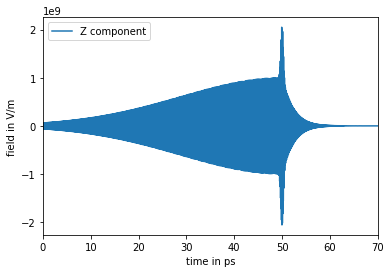See the extensive Documentation on ReadTheDocs
Overview | Quick install | Quick Start | Examples | Citing richmol
Richmol is currently being developed and maintained by the Theory team of the CFEL Controlled Molecule Imaging group at Deutsches Elektronen-Synchrotron DESY and Universität Hamburg. We hope to attract collaborators for a joint development by a larger community of researchers working in fields of molecular nuclear-motion dynamics, spectroscopy, and laser alignment and coherent control of molecules.
Richmol is intended for computing molecular rotational and ro-vibrational energy levels, spectra, and field-induced dynamics. It can be interfaced with other similar variational codes, such as, for example, TROVE and Duo. We welcome any feedback, feature requests, issues, questions or concerns, please report them in our discussion forum or the issue tracker.
Richmol is a library for simulating molecular nuclear motion dynamics and related properties.
It is based on Python, some of its parts, for example, time-dependent propagation, can run on GPUs using numba and cupy libraries.
Richmol can be used for predicting:
- Rotational energy levels and spectra (
richmol.rot,richmol.spectrum): Watson Hamiltonians in A and S reduction forms, user-built custom effective rotational Hamiltonians, electric dipole, magnetic dipole, electric quadrupole, and Raman spectra - Rotational field-induced dynamics (
richmol.field,richmol.tdse): simulations of rotational dynamics and related properties of molecules placed in static and time-dependent fields - Ro-vibrational dynamics and spectra (currently via interface with TROVE): simulations of spectra and ro-vibrational dynamics of molecules in static and time-dependent fields
- Non-adiabatic dynamics of diatomic molecules (via interface with Duo): field-induced dynamics of diatomic molecules including non-adiabatic and spin-orbit coupling effects
We plan to include following new features in the next release:
- Hyperfine effects (
richmol.hyperfine): spectra and dynamics on hyperfine states, including nuclear quadrupole, spin-spin, and spin-rotation interactions - VMI observables (
richmol.vmi): time-evolutions of 2D projections of probability density functions for selected molecular groups (in axial-recoil approximation)
Latest version
> pip install --upgrade git+https://github.com/CFEL-CMI/richmol.git
Some of modules (e.g. spectrum) require MPI libraries to be installed on your system, you can install them using
> apt install libopenmpi-dev
> pip install mpi4py
alternatively
> brew install mpich
> conda install mpi4py
In Richmol, calculations of rotational (and generally ro-vibrational) dynamics proceeds in two steps. At the first step, molecular energy levels and matrix elements of molecule-field interation tensors (multipoles) are computed. These are then used in the second step for calculation of molecular dynamics in static or time-dependent external electric and/or magnetic fields.
The calculations of field-free molecular rotational or ro-vibrational energy levels and wave functions can be extremely tedious and can, in principle, be done using other variational codes. One of such programs is TROVE, that can be used to generate accurate ro-vibrational energies, wave functions, and matrix elements of various molecule-field interaction tensors for small and medium size molecules. These can be stored in an HDF5 file and later used by Richmol for simulations of molecular spectra or dynamics. A collection of such HDF5 data files for different molecules is available through Richmol molecular database section of the main documentation.
Below, we show few simple examples of simulations using pure rotational states. For more examples and tutorials, please see our examples folder and main Documentation
Compute rotational energies and matrix elements of dipole moment and polarizability for water molecule using data obtained from a quantum-chemical calculation
from richmol.rot import Molecule, solve, LabTensor
water = Molecule()
# Cartesian coordinates of atoms
water.XYZ = ("bohr",
"O", 0.00000000, 0.00000000, 0.12395915,
"H", 0.00000000, -1.43102686, -0.98366080,
"H", 0.00000000, 1.43102686, -0.98366080)
# choose frame of principal axes of inertia
water.frame = "ipas"
# molecular-frame dipole moment (au)
water.dip = [0, 0, -0.7288]
# molecular-frame polarizability tensor (au)
water.pol = [[9.1369, 0, 0], [0, 9.8701, 0], [0, 0, 9.4486]]
# symmetry group
water.sym = "D2"
# rotational solutions for J=0..5
Jmax = 5
sol = solve(water, Jmin=0, Jmax=Jmax)
# laboratory-frame dipole moment operator
dip = LabTensor(water.dip, sol, thresh=1e-12) # neglect matrix elements smaller than `thresh`
# laboratory-frame polarizability tensor
pol = LabTensor(water.pol, sol, thresh=1e-12)
# field-free Hamiltonian
h0 = LabTensor(water, sol, thresh=1e-12)Once computed, rotational solutions and matrix elements can be stored in an HDF5 file. A collection of pre-computed HDF5 files containing rotational, ro-vibrational, and even hyperfine solutions and matrix elements for different molecules are available through Richmol molecular database section of the main Documentation. Here is how the matrix elements can be stored in HDF5 file
dip.store("water.h5", replace=True, comment="dipole moment in au computed using CCSD(T)/AVTZ")
pol.store("water.h5", replace=True, comment="polarizability in au computed using CCSD(T)/AVTZ")
h0.store("water.h5", replace=True, comment="rot solutions from CCSD(T)/AVTZ equilibrium geometry")and how they can be read
from richmol.field import CarTens
dip2 = CarTens(filename="water.h5", name="dip")
print("dipole:", dip2.__doc__)
pol2 = CarTens(filename="water.h5", name="pol")
print("polarizability:", pol2.__doc__)
h02 = CarTens(filename="water.h5", name="h0")
print("field-free H0:", h02.__doc__)
# prints out
# dipole: Cartesian tensor operator, store date: 2021-06-09 14:32:36, comment: dipole moment in au computed using CCSD(T)/AVTZ
# polarizability: Cartesian tensor operator, store date: 2021-06-09 14:32:36, comment: polarizability in au computed using CCSD(T)/AVTZ
# field-free H0: Cartesian tensor operator, store date: 2021-06-09 14:32:37, comment: rot solutions from CCSD(T)/AVTZ equilibrium geometryOnce the field-free molecular solutions and matrix elements are obtained, the simulations of field-induced dynamics are straightforward. Here is an example of the simulation of Stark effect for water molecule
import numpy as np
from richmol.convert_units import AUdip_x_Vm_to_invcm
import matplotlib.pyplot as plt
enr = []
muz = []
fz_grid = np.linspace(1, 1000*100, 10) # field in units V/m
muz0 = dip.tomat(form="full", cart="z") # matrix representation of Z-dipole at zero field
print(f"matrix dimensions:", muz0.shape)
for fz in fz_grid:
field = [0, 0, fz] # X, Y, Z field components
# Hamiltonian
h = h0 - dip * field * AUdip_x_Vm_to_invcm() # `AUdip_x_Vm_to_invcm` converts dipole(au) * field(V/m) into cm^-1
# eigenproblem solution
e, v = np.linalg.eigh(h.tomat(form='full', repres='dense'))
# keep field-dressed energies
enr.append([elem for elem in e])
# keep field-dressed matrix elements of Z-dipole
muz.append( np.dot(np.conj(v.T), muz0.dot(v)) )
# plot the results for selected state index
enr = np.array(enr)
muz = np.array(muz)
istate = 0 # choose state index
fig, (ax1, ax2) = plt.subplots(1,2, constrained_layout=True)
plt.suptitle(f"state #{istate}")
ax1.set_ylabel("energy in cm$^{-1}$")
ax1.set_xlabel("field in V/m")
ax2.set_ylabel("$\\mu_Z$ in au")
ax2.set_xlabel("field in V/m")
ax1.plot(fz_grid, enr[:, istate])
ax2.plot(fz_grid, muz[:, istate, istate].real)
plt.show()Here is an example of the simulation of 'truncated-pulse' alignment for linear OCS molecule. To begin, we compute the field-free energies, matrix elements of polarizability interaction tensor, and matrix elements of cos2θ, that is used to quantify the degree of alignment
from richmol.rot import Molecule, solve, LabTensor
from richmol.tdse import TDSE
from richmol.convert_units import AUpol_x_Vm_to_invcm
from richmol.field import filter
import numpy as np
import matplotlib.pyplot as plt
ocs = Molecule()
ocs.XYZ = ("angstrom",
"C", 0.0, 0.0, -0.522939783141,
"O", 0.0, 0.0, -1.680839357,
"S", 0.0, 0.0, 1.037160128)
# molecular-frame dipole moment (in au)
ocs.dip = [0, 0, -0.31093]
# molecular-frame polarizability tensor (in au)
ocs.pol = [[25.5778097, 0, 0], [0, 25.5778097, 0], [0, 0, 52.4651140]]
Jmax = 10
sol = solve(ocs, Jmax=Jmax)
# laboratory-frame dipole moment operator
dip = LabTensor(ocs.dip, sol)
# laboratory-frame polarizability tensor
pol = LabTensor(ocs.pol, sol)
# field-free Hamiltonian
h0 = LabTensor(ocs, sol)
# matrix elements of cos^2(theta)
cos2 = LabTensor("cos2theta", sol) # NOTE: you need to add a constant factor 1/3 to get the true valuesNow, we define the external electric field. Here, it is loaded from file trunc_pulse.txt. The field in units V/cm has a single Z component and is defined on a time grid ranging from 0 to 300 picoseconds
# truncated-pulse field
with open("trunc_pulse.txt", "r") as fl:
field = np.array([[float(elem) for elem in line.split()[1:]] for line in fl]) # X, Y, Z field's components
fl.seek(0)
times = [float(line.split()[0]) for line in fl] # time grid
# convert field from V/cm to V/m
field *= 1e2
# plot Z component
plt.plot(times, field[:, 2], label="Z component")
plt.xlim([0,70]) # plot first 70 ps
plt.xlabel("time in ps")
plt.ylabel("field in V/m")
plt.legend()
plt.show()For the initial state distribution we assume a hypothetical temperature of T = 0 Kelvin
and use eigenfunctions of the field-free operator h0 as the initial state vectors.
Run dynamics from time zero to 200 ps with a time step of 10 fs,
plot the expectation values of cos2θ
and compare them with reference values
tdse = TDSE(t_start=0, t_end=200, dt=0.01, t_units="ps", enr_units="invcm")
# initial states - Boltzmann-weighted eigenfunctions of `h0`, at T=0 K - only ground state
vecs = tdse.init_state(h0, temp=0)
# interaction Hamiltonian
H = -1/2 * pol * AUpol_x_Vm_to_invcm() # `AUpol_x_Vm_to_invcm` converts pol[au]*field[V/m] into [cm^-1]
# matrix elements of cos^2(theta)
cos2mat = cos2.tomat(form="full", cart="0")
cos2_expval = []
for i, t in enumerate(tdse.time_grid()):
# apply field to Hamiltonian
H.field([0, 0, field[i, 2]])
# update vector
vecs, t_ = tdse.update(H, H0=h0, vecs=vecs, matvec_lib='scipy')
# expectation value of cos^2(theta)-1/3
expval = sum(np.dot(np.conj(vecs[i][:]), cos2mat.dot(vecs[i][:])) for i in range(len(vecs)))
cos2_expval.append(expval)
if i % 1000 == 0:
print(t, expval+1/3)
# compare with reference results
plt.plot([t for t in tdse.time_grid()], [elem.real + 1/3 for elem in cos2_expval], 'b', linewidth=4, label="present")
with open("trunc_pulse_cos2theta.txt", "r") as fl:
cos2_expval_ref = np.array([float(line.split()[1]) for line in fl])
fl.seek(0)
times_ref = np.array([float(line.split()[0]) for line in fl])
plt.plot(times_ref, cos2_expval_ref, 'r--', linewidth=2, label="reference")
plt.xlabel("time in ps")
plt.ylabel("$\cos^2\\theta$")
plt.legend()
plt.show()For more examples and tutorials, please see our examples folder and Documentation
To refer to this project in scientic work please cite the following manuscript:
Cem Saribal, Guang Yang, Emil Zak, Yahya Saleh, Jannik Eggers, Vishnu Sanjay, Andrey Yachmenev, and Jochen Küpper: "Richmol: Python package for variational simulations of molecular nuclear motion dynamics in fields", Comput. Phys. Commun., in preparation (2021); the current version of the software is available on GitHub
@article{richmol2021github,
author = {Cem Saribal and Guang Yang and Emil Zak and Yahya Saleh Jannik Eggers and Vishnu Sanjay and Andrey Yachmenev and Jochen Küpper},
title = {{R}ichmol: {P}ython package for variational simulations of molecular nuclear motion dynamics in fields},
journal = {Comput. Phys. Commun.},
year = {2021},
volume = {in preparation},
note = {The current version of the software is available on \href{https://github.com/CFEL-CMI/richmol}{GitHub}},
}



